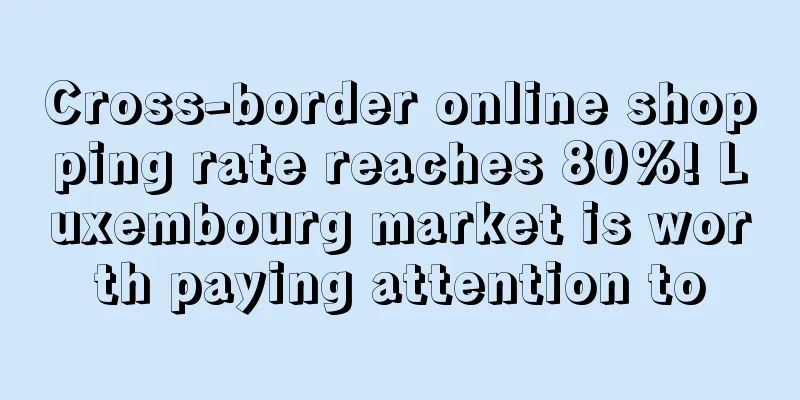Cross-border online shopping rate reaches 80%! Luxembourg market is worth paying attention to

|
Europe is another big piece of cake for cross-border e-commerce sellers, and its market size cannot be underestimated. Except for the popular UK and Germany, other countries are still performing strongly.
In 2020 , the total turnover of European cross-border e-commerce was 146 billion euros, a year-on-year increase of 35%. And according to statistics , one-quarter of Europeans' online shopping is cross-border.
Among them, Luxembourgers make the most cross-border online purchases, while the Dutch make the least . Belgium's cross-border e-commerce turnover is still growing rapidly, and the largest e-commerce market is in Germany.
Luxembourg ranks first
Luxembourg ranks first among the top 16 European cross-border e-commerce countries . An important reason is the high Internet penetration rate, with 94% of residents active online, and the proportion of cross-border online shopping reaching more than 80%. Shopping platforms are mainly concentrated on Amazon Germany and Amazon France, as well as local platforms Zalando, Asos, Veepee, and Fnac. Consumer categories are mainly clothes, shoes, and accessories.
Belgium sees strong growth
Affected by the epidemic, Belgium 's cross-border e-commerce has seen significant growth in 2020, with turnover reaching 4 billion euros, a year-on-year increase of 53%. The main shopping platforms are Zalando, Zara, H&M, Amazon, Wish and AliExpress.
Germany has the most e-commerce platforms
Germans' preferred shopping platform is Amazon, with sales reaching 13 billion euros in 2020. In addition, there are local platforms such as Otto and Zalando. The main consumption directions are electronics and media, followed by fashion.
Sweden ranked second
Benefiting from the influence of H&M, Sweden ranks second. The local online penetration rate reaches 73%. The largest e-commerce market is the fashion industry, accounting for 31% of Sweden's e-commerce revenue. The second largest market is electronic media.
Cross-border e-commerce in France is growing slowly, and local Fnac, Carrefour and La Redoute are also constantly expanding their markets. After Brexit, cross-border trade in the UK has been negatively affected to a certain extent.
From this perspective, the European e-commerce market is mainly composed of fashion and electronic categories. It is understood that during the 2020 epidemic, the online shopping rate in Europe reached 96%. Now that the epidemic has improved and the offline market has opened, 74% of Europeans have stated that they will not reduce online shopping. Cross-border e-commerce Europe |
<<: Online fashion platform Secret Sales completes Series A financing, raising €10 million
>>: The first cross-border e-commerce payment stock is here! Payoneer successfully listed in the US
Recommend
What is Huize Supply Chain? Huize Supply Chain Review, Features
Huize Supply Chain is a cross-border logistics co...
What is gu-de? gu-de Review, Features
gu-de was founded by Korean designer Koo Who in 20...
Cross-border e-commerce at the CIFTIS: Bank of Beijing launches comprehensive cross-border e-commerce financial service program
On September 4, at the "Cross-border E-comme...
What is NotjustAgency? NotjustAgency Review, Features
NotjustAgency focuses on overseas D2C brand marke...
TikTok joins the Black Friday shopping war with force, will Amazon sellers’ traffic be at risk?
Last Saturday, Bloomberg reported, citing insider...
US e-commerce logistics platform ShipBob receives $200 million in financing, with a valuation of over $1 billion
Recently, ShipBob, a cloud-based logistics platfo...
Something went wrong again! A large number of Amazon sellers have abnormal orders
“I don’t know what Amazon is up to!” Although Ama...
British Easter spending budgets rise! Searches for holiday items surge
Recently, online shopping website Very released t...
Logistics industry grows significantly! Vietnam hopes to solve infrastructure problems
As the global pandemic spreads , Vietnam is expec...
Shipments in the first quarter reached 1.89 million units! Korea's PC market is experiencing growth
Affected by the epidemic, the South Korean govern...
What is Jingzhuntong Testing and Certification (Guangdong) Co., Ltd.? Jingzhuntong Testing and Certification (Guangdong) Co., Ltd. Review, Features
Jingzhuntong Testing and Certification (Guangdong)...
A team of 5 people, 2 products, and sales of 200 million yuan a year
If it weren't for a melon in the entertainmen...
What is Oodle.com? Oodle.com Review, Features
<span data-docs-delta="[[20,"Oodle.com&quo...
China surpasses Germany to become UK's largest import trading partner
On May 25 , according to data released by the UK ...
What is Huabo Cloud Link (TikTok Network Solution)? Huabo Cloud Link (TikTok Network Solution) Review, Features
Huabo Yunlian-TikTok Little Rocket is based on th...









